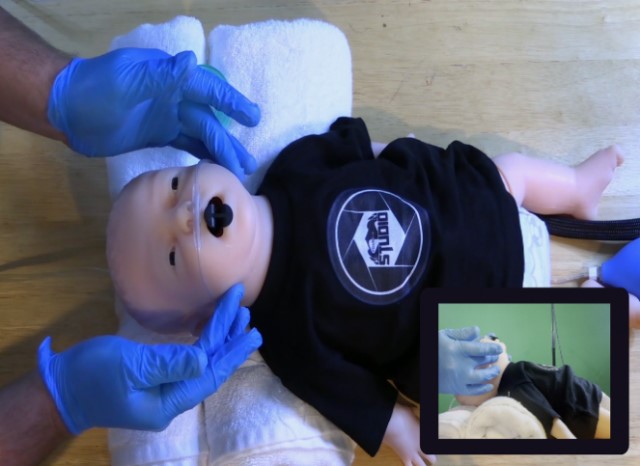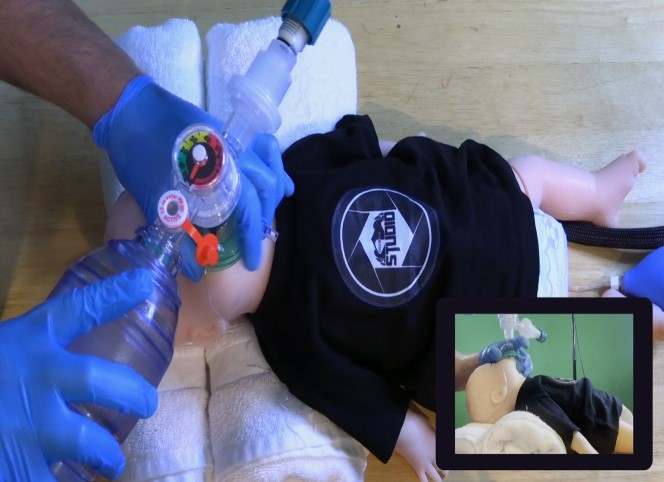After starting my nursing career in adult critical care, I found myself transitioning to neonatal-pediatric critical care, drawn by some unknown force! I always enjoyed children but did not particularly enjoy sick children. Luckily for me, I had amazing mentors and now have a wonderful career caring for this precious patient population and their families.
The differences between adult and pediatric patients are amazing and scary all at the same time. I quickly realized that with weight-based medication dosages, a decimal in the wrong place could be extremely detrimental to my pediatric patients. Children can have less complex medical histories than our adult patients, but this does not mean children are easier to care for. Pediatric patients have fewer physiological reserves and can compensate with normal vital signs for longer, but then they can crash quickly. Kids do not present the same way adults do with cardiac conditions, sepsis and other health emergencies. That is why I want to discuss what makes pediatric patients different from adults, ultimately answering the question - what makes a kid, a kid?
Basic Differences Between Kids and Adults
Assessing Pediatric Patients: Where do I start?When assessing kids, an easy go-to tool is the Pediatric Assessment Triangle. This tool applies the components of appearance, work of breathing and circulation with an across-the-room look to assess “sick or not sick.” Part of assessing children is establishing trust, and based on the developmental stage of the child (remember Erikson, Freud and Piaget?!), you want to keep them calm, or you can forget about obtaining a good physical assessment. Therefore, getting as much information as you can before physically assessing them is very helpful. And distraction is golden: Using an electronic device, singing a song, letting them use your stethoscope, or demonstrating with a stuffed animal can really help!
Vital Signs- Important: Vital signs vary based on the age of the patient.
- BP: Obtaining a blood pressure (BP) on a child younger than 3 years of age is not routinely performed unless monitoring a specific disease process, or if the child is unstable.
- The lower limit of systolic BP (5th percentile) for age may be estimated by this formula: 2 x (age in years) + 70: This is the lowest you should be comfortable with.
- Make sure you have an appropriately sized BP cuff! A cuff that is too small can lead to a falsely elevated BP, which may mask signs of sepsis, and a cuff that is too large contributes to an inaccurate, lower BP. It is important to obtain an accurate BP before you start resuscitating with fluids and/or vasopressors to establish a baseline.
- RR: Children at any age should not have a respiration rate (RR) > 60 for a sustained period.
- HR: Normal heart rate (HR) is roughly 2-3 times normal RR for that age.
- CO: Remember the formula for cardiac output (CO)? Cardiac output = heart rate x stroke volume:
- Think of what goes into stroke volume (preload, afterload and contractility), and recall that when any of these factors are compromised, CO can be compromised. The child cannot alter those parameters like an adult can. The only ability a child has to increase their CO is to increase their HR.
- Get a Weight: While not a vital sign (VS), getting an accurate weight when caring for pediatric patients is essential, because pediatric medications are weight-based. In a code or urgent situation, you can use a weight-assessment tape, such as a Broselow Tape, per your facility’s policy and procedure.
- PEDIATRIC PEARL: Pediatric patients are the “great pretenders,” meaning that their VSs appear stable or near stable until the very end. Don’t wait for VS changes to act on assessment findings! If the child’s HR is elevated and you've ruled out pain and fever as a potential etiology, it could be telling you something else!
- Temp Control: Children have a high body surface area to volume ratio, but low heat production. Infants have muscle tone that is less mature and, therefore, have a decreased ability to shiver to produce heat. These features increase pediatric patients’ risk for ineffective thermoregulation.
- BG Regulation: Children tend to have increased blood glucose (BG) requirements due to a higher metabolic rate, their liver is less mature with decreased glycogen stores, and stress can induce hypo- or hyperglycemia.
- “Hypothermia and hypoglycemia are two friends that are not allowed to hang out together because they make poor choices.” If you have a patient who is hypothermic, chances are your patient is or will become hypoglycemic (and vice versa). Both hypothermia and hypoglycemia can contribute to pediatric codes. This is particularly true for infants.
- PEDIATRIC PEARL: Consider a point-of-care glucose on all infants and ill-appearing or unstable children, and confirm with serum glucose from a lab, if available.
- Respiratory Risks: Infants and young children have anatomic and physiologic characteristics that predispose them to respiratory distress. First, a child’s head is larger in proportion to their body than an adult’s. They also have high, anterior airways that can restrict the airway, and their upper airways are more prone to airway and subglottic collapse. These factors are important to consider when positioning for airway management.
- Lung Limitations: The pediatric respiratory system does not reach maturity until 7-8 years of age. The alveoli have less surface area for gas exchange, less elastic recoil and less supportive tissue. Smaller lower airways predispose infants to mucus plugs and ventilation/perfusion mismatch as well as immature intercostal muscles and ribs that are cartilaginous – allowing for chest wall collapse rather than expansion during distress – which we can see as retractions. Their tidal volumes are largely dependent on the movement of their diaphragm, so high intrathoracic pressure or abdominal distention can compromise respiration.
- Unique Infants: Infants are obligate nose-breathers until around 6 months of age, so keeping their nares clear of secretions can make a big difference for their respiratory efforts. Neurologically, their central nervous system is immature and less able to compensate for stressors such as hypercarbia, hypoxia and acidosis. Their metabolic rate can be twice that of an adult, which increases their oxygen consumption. Their epiglottis is floppier and shaped differently, and the trachea is shaped more like a funnel than a cylinder. Their tongues are big, which really can be an issue with positioning and intubation or providing positive pressure ventilation (PPV) with a bag-valve-mask (BVM). I always envision their tracheas like a bendable straw you might use when drinking a soda: Think of this when trying to position in the “sniffing” position to establish ventilation, as well as how small the airways are when you consider any disease process that can cause edema (a coffee stir stick vs. a jumbo straw).


Photos: I love this simulated picture of positioning a child while preparing for an intervention, such as an advanced airway. It is important to recognize proper positioning with pre-oxygenation when planning to use an advanced airway.
Also note that patients younger than 1 year of age (or per your organization’s policy or procedure) can have a sensitive vagal response, so using atropine during rapid sequence intubation (RSI) may be of benefit. Photo credit: FOAMfrat
- PEDIATRIC PEARLS:
- Start with positioning: Head of bed (HOB) should be up.
- Suctioning is magic! Especially during bronchiolitis season.
- Try to keep the child (and yourself) calm. Use distraction techniques.
- Recognize upper vs. lower airway issues and treat accordingly.
- Oxygen saturation goals should be > 90%. If the patient is using a mask, make sure it is the correct size, and always consider placing an NG/OG for CPAP, BiPAP or prolonged bag-mask ventilation.
- Baselines Vary: It is important to know the baselines for patients with diagnoses such as anxiety, depression, attention-deficit/hyperactivity disorder, autism spectrum disorder and what may be triggers or sensitivities for the child. Keeping the patient and yourself safe is a priority. Always include the caregiver and establish a baseline.
- Interactions Are Important: Observe the interactions between the child and their caregiver, and whether they are appropriate or inappropriate considering the child’s normal baseline.
- PEDIATRIC PEARL: Good behavioral health management includes preventing escalation and using resources specific to the child.
- Smaller Bodies = Multiple Organ System Injury: The smaller the child, the greater the likelihood that a single impact will injure multiple organ systems. Consider how a 2-year-old struck by a car may have different injuries than a 14-year-old. The shape of the diaphragm in pediatric patients younger than 2 years is flatter than that of adults, which makes children more susceptible to injuries in their abdominal organs, such as the liver, spleen and duodenum.
- Renal Trauma: Children are at a greater risk of renal trauma as their kidneys are larger in proportion to their abdominal cavity than adults.
- C-Collar Sizing: Sizing a pediatric c-collar is important and can be a challenge. The younger the patient, the harder it is to immobilize the neck, since pediatric patients younger than 1 year of age seem to have no neck! Ensure best sizing practices per your facility’s policy and procedure and the manufacturer’s instructions for your c-collar product.
- Differences in Body Types >> Different Injury Risk: Children have a larger body-to-mass ratio, placing them at higher risk of sustaining injury due to blunt trauma. In blunt trauma, the forces are concentrated over a larger area, which can cause more harm in children than adults. Therefore, multisystem injuries in the presence of blunt trauma should be assumed until proven otherwise. The pediatric spine starts to resemble an adult spine after about age 8. The head is larger in proportion to the body and kids have a higher fulcrum than adults, which makes injuries from the occiput to C3 more prevalent. Children have weaker paraspinal musculature support and interspinous ligaments, as well as flat facet joints and anteriorly wedged vertebral bodies. All these elements should be considered for the pediatric population.
- Keep Kids Warm: Preventing or addressing hypothermia in trauma and otherwise is paramount. It is important to warm the patient and the environment, administer warmed fluids/blood products, and be mindful that the pediatric patient has a blood volume of 80 mL/kg, so it doesn’t take much volume loss, or replacement with IV fluids or blood products to see a physiologic change. *See discussion of BP parameters in this article.
- NAT: Non-accidental trauma (NAT) is something to think about carefully for the pediatric population. Injuries that are inconsistent with reports must be noted. Healthcare workers are mandated reporters, so if there is a suspicion of NAT or neglect it must be reported.
- PEDIATRIC PEARL: Until there is definitive testing, it is important to maintain c-spine precaution with a c-collar and supine positioning.
Treat Kids Like Kids
Treat a pediatric patient as just that: a pediatric patient! Involving the family and other caregivers in patient care is a huge benefit and can give us valuable insight into the needs of the child during and after discharge from our care. Know and use your resources, and you will make a difference in a kid’s life!
ResourcesWhat are your favorite pediatric care resources?

Are you sure you want to delete this Comment?